Discover the captivating charm of Japan! A one-of-a-kind cultural experience, mouth-watering cuisine, and marvel at the breathtaking natural beauty.

Content
- Where is Japan
- A Bit about the Culture of Japan
- Attend an Ancient tea ceremony
- 6 Types of Japanese Theatre not seen in the Western World
- What type of Homes will you see in Japan?
- How do you Greet People in Japan?
- 7 Epic Etiquette Tips While in Japan
- 10 Protocol tips on how to use Chopsticks
- How to Travel Around Japan
- What tourists love to See and Visit in Japan
Where is Japan
Nihon or Nippon (origin of the sun) is the name for Japan, a name given by the Japanese people. Did you know Japan encompasses 6852 islands? It is comprised of five larger islands and numerous smaller islands, located in the North Pacific Ocean. It is off the coast of the Asian Continent. South Korea and Russia are the two closest countries. South Korea is only 1.03 hours flight time to Japan.
On the west is the Sea of Japan. Japan’s territory is 377 975.24 square km. 73% of the country is mountainous so the majority of the 127 million people live on the coastline. The result is a highly densely populated country.
The five main islands are Okinawa (smallest and least populated), Kyushu (third largest), Shikoku (second-smallest), Honshu: also called Hondo (is the largest and most populated) and where Tokyo the capital and Hokkaido (second largest).
Around the Greater Tokyo Area, it is the most populated metropolitan area in the world. Tokyo, the capital, is very advanced technologically and the air pollution level is PM2, which means its air quality is in a good bracket.
Going to Japan is a true adventure and read my article Where to Stay in Japan: A Westerners Perspective to understand the different types of accommodation.
An interesting fact is that you do not see many rubbish bins in Tokyo, yet instead of an increase in littering, there is a decrease!
The majority of the earth’s volcanoes and earthquakes take place along the Pacific Ring of Fire, which is a rim around the Pacific Ocean. This is a horseshoe-shaped belt that is approximately 500 meters wide and 40 000 km long. Japan is located along this Ring of Fire so is prone to earthquakes, volcanoes, floods, tsunamis, and typhoons. Although the majority occur on a small scale it is wise to know what to do in a natural disaster while visiting.
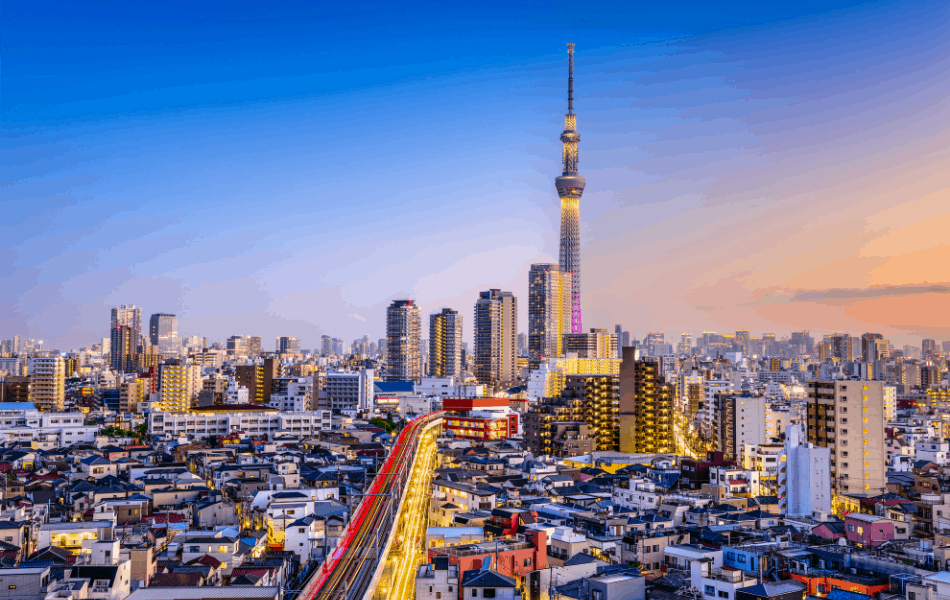
A Bit about the Culture of Japan
National Language
The national language is Japanese. It was highly influenced by the Chinese culture, but during the Edo period when it closed its doors to the outside world a distinctly Japanese culture arose. After the fall of that era in 1868, influences from all over the world started to emerge.
Religion
The two main religions are Shinto, which is about 3.9% of the population, and the Japanese religion. 39% are Buddhist which stemmed from China and Korea in the 6th century. 2.3% are Christian. Shinto believers believe in more than one god (polytheistic) and have no founder or script. There most important thing is purity. Their deities (gods or goddesses) are treasured and protected in shrines. Buddhism on the other hand has a script and was founded by Buddha.
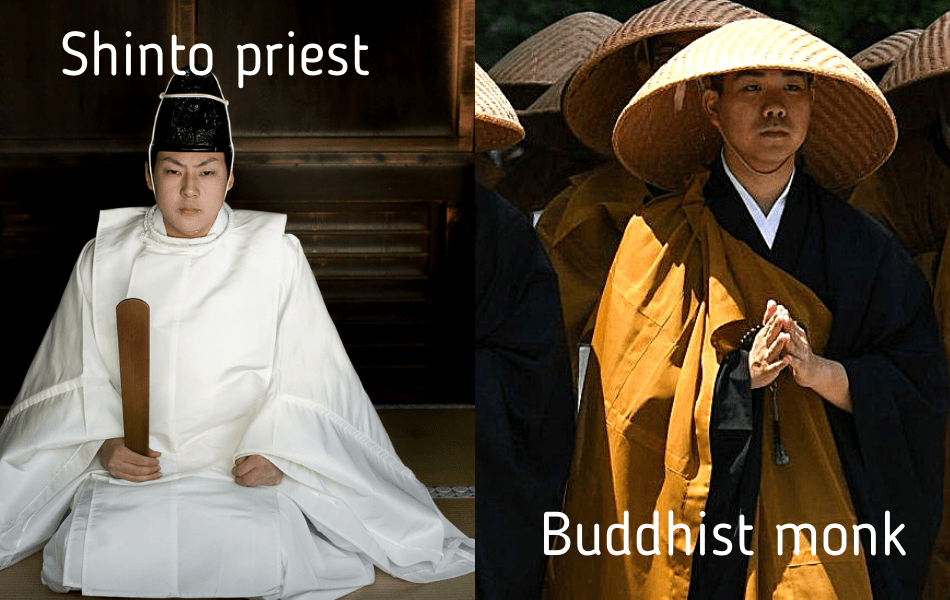
What they love
The Japanese love music and video games, anime (hand-drawn and computer animation, which originated in Japan), Japanese cinema, television programs, and graphic or comic novels which are known as manga, which were initiated in Japan. Japanese theatre and puppetry you have to experience! All of these have a foundation in their traditions and ancient culture.
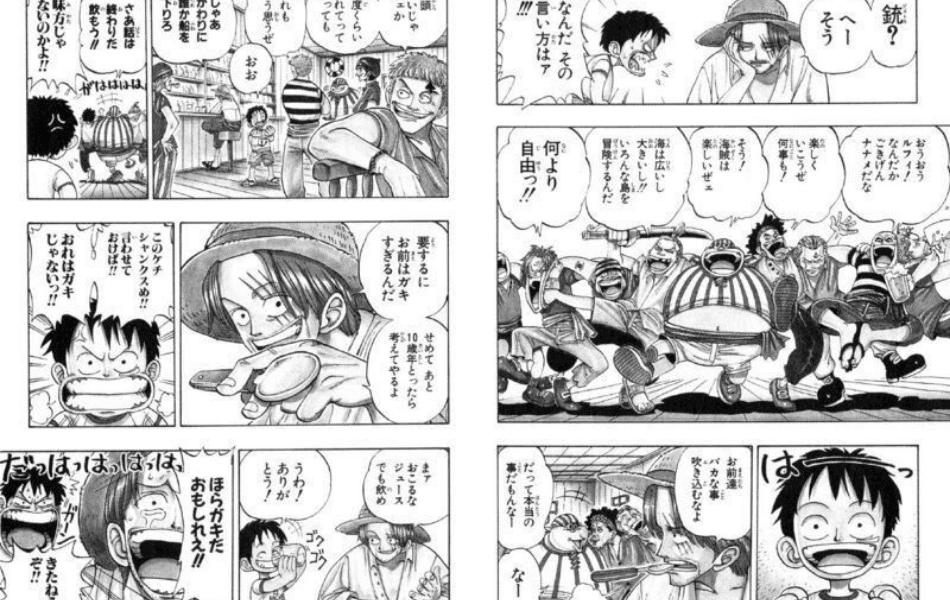
Karaoke where people sing along to recorded music and have a microphone, which was invented in Japan and translates into English as “empty orchestra”, is a huge rave. It is so popular that karaoke cubicles occupy several floors of buildings.
Japanese food
Japanese food has a distinct culture of its own. They predominantly eat fish. The preparation method is just as important as the eating. Agar jelly which is made from red algae is used in many traditional dishes. As iron deficiency is fairly common in Japan, they believe one should have a bit of hijiki every day. This is rich in calcium and iron.
Negi which is a type of leek is predominant in their cuisine. Daikon, giant radishes that grow everywhere and even though fairly tasteless, are included in numerous dishes. Anko which is mashed azuki beans is made as a priority ingredient in desserts. It is sweet and definite instead of sugar. Soybeans are eaten for breakfast, lunch, and dinner! An absolute obsession! Soybeans make tofu, which is consumed by each person 3 to 4 times a week in their dishes.
Miso soup is a traditional favorite. Soy sauce is one of my personal favorites! Kinako is a roasted soybean flour that is sweet and used instead of sugar. Great ice cream with its unique taste is made from kinako. Nori is filled with vitamins and minerals and is tasty. Sushi and ingredients such as fish and rice, are rolled in nori, known as Makizushi. Rice is mostly eaten every day. Well, I could write a whole blog on their varied diet! So matchless! I am mad about sushi!
Attend an Ancient tea ceremony
Ancient tea ceremonies are very much part of the Japanese people. The ceremony is served in a simple, sparse tea room with tatami mats on the floor. The purpose of the tea ceremony is to create bonding between the guest and the host and to create inner peace, harmony, happiness, comfort, and the art of purification together. It takes years to become a tea ceremony “master”.
Sweets are also served at the ceremony to counter the bitter green tea. Did you know that the cups in which the tea is served, have no handles? Read up on this fascinating tea ceremony. It is worth the read and it will give you guidance on how to behave when you go to your first tea ceremony.
6 Types of Japanese Theatre not seen in the Western World
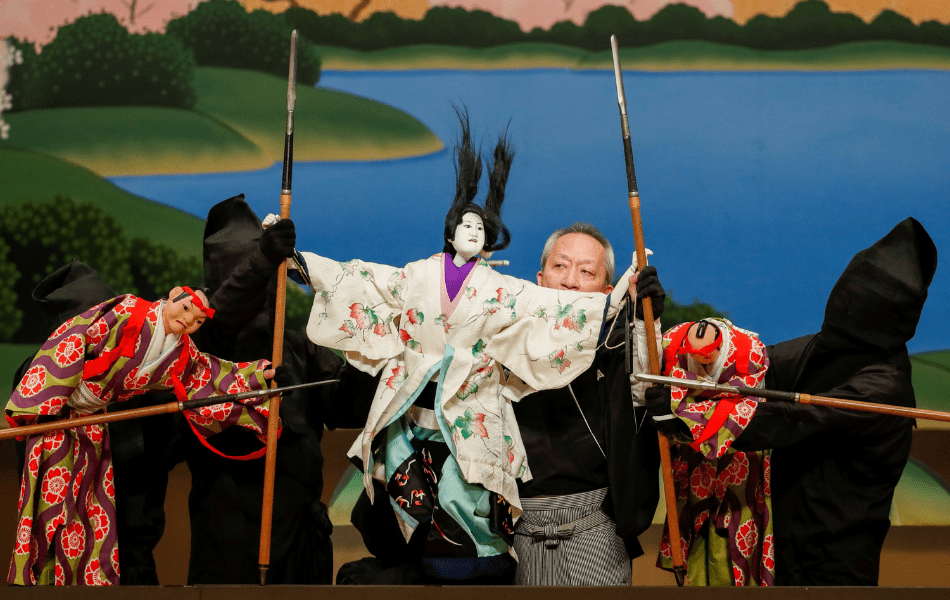
Japanese theatre goes back centuries. It comprises dance, and music and is very melodramatic! Full of symbolism. Western-influenced theatre is seeping into Japan, but when in Japan go to a traditional Japanese theatre.
Takarazuka has a more modern appeal and reminds me slightly of Bollywood from India. Here are 6 different types for you to choose from. Even though Japanese is spoken, you will get the gist of the story as it is so expressive.
| Bunraku | Bunraku which is a puppet theatre is recognized as a UNESCO Intangible Cultural Heritage. Each puppet is operated by a principal operator and 2 assistants. They will be dressed in black, symbolizing that they are invisible. The puppets themselves are large, about half the size of an adult. The multiple voices of all the puppets are spoken by one person and his ability to speak in a woman’s voice, a child, or a man’s is amazing. He also tells the story. Expressions and poses presented by these puppets are an absolute art! Tales based on historical events are very popular. The National Bunraku Theatre in Osaka is the best place to watch. |
| Takarazuka | This is musical theatre played by an all-women cast in Takaraxuka. Takarazuka Revue is probably the most famous theatre company in the country. It was founded over 100 years ago by the president of Hankyu Railways who wanted to attract travelers to Takarazuka. Something that was different and unique. Today the loyal followers of the theatre and cast are immense. You will need to book in advance to attend one of the shows. Costumes are bold, glitzy, and brash! Only 50 girls per year are accepted into the prestigious Takarazuka Music School, where strict training occurs. Tokyo also has a Takarazuka Theater. |
| Kabuki | Kabuki is one of Japan’s 3 most classical theatre styles. The actors wear heavy traditional makeup. It embraces mime, dance, and music. The costumes and sets are ornate and decorative. The art form has generally been unchanged for centuries. It focuses more on elaborate looks than the story. Even though the art of kabuki was created by a woman, all the actors today are male. Kabuki-za in Ginza is the best theatre to go to in Tokyo. |
| Noh | Here the traditional dance performances are performed with actors wearing masks. If the actor moves into a certain position, the mask gives the impression that the emotion has changed. It is the most ancient living form of theatre. The actors have to know the ancient scripts in Japanese. It is an extremely difficult form of art to perform. The plays are short and there is little dialogue. The performance relies on music, movement and masks to tell the story. The National Noh Theatre in Sendagaya is devoted to Noh. |
| Geisha Dances | Each year in spring, there are two performances. These young ladies train for a period of 5 years and are known as maiko. They become highly skilled in dance, singing and performance. Once completely trained they become “geiko”. You can tell the difference between maiko and geiko by their dress. Maikos long sleeve kimonos are colourful and their own hair is tied up with numerous kanzashi (hairpins). The geiko, on the other hand, wears plainer, shorter-sleeved kimonos and their hair does not have so many hairpins. These performers also perform for private functions and at upmarket restaurants. Let us relate Geisha Dances to Western Ballet. |
| Kyogen | Kyogen was often played between noh acts. It is a light comedy, rather a slapstick. The actors are extremely expressive and often silly. |
What type of Homes will you see in Japan?
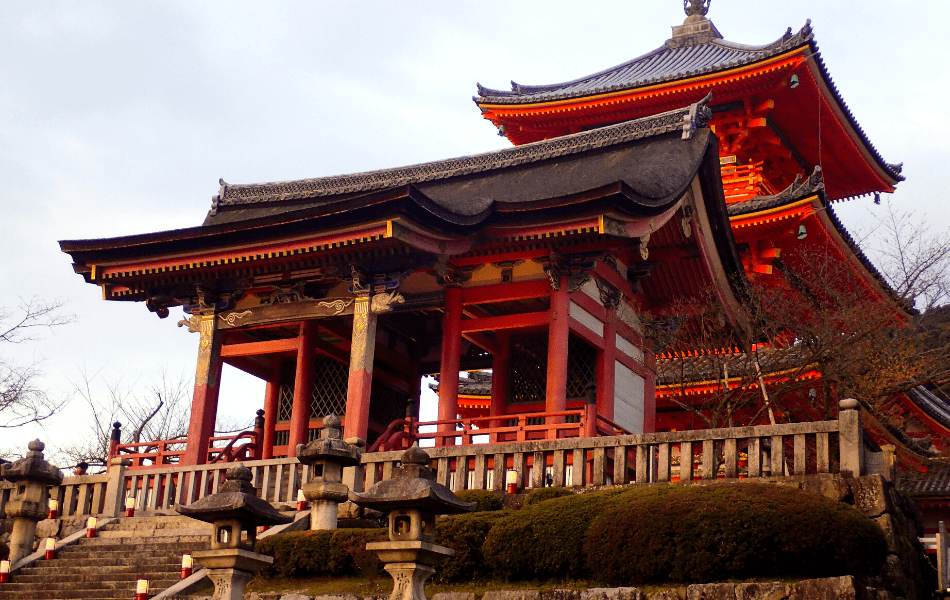
I love seeing the difference in homes compared to the West when I travel. It totally fascinates me! Japanese houses are called Minka. Their roofs are gently curved at the corners so further light comes in, especially during winter. Their floors are made from tatami, which is made from rice straw. Fabulous on the feet and the smell is very pleasant.
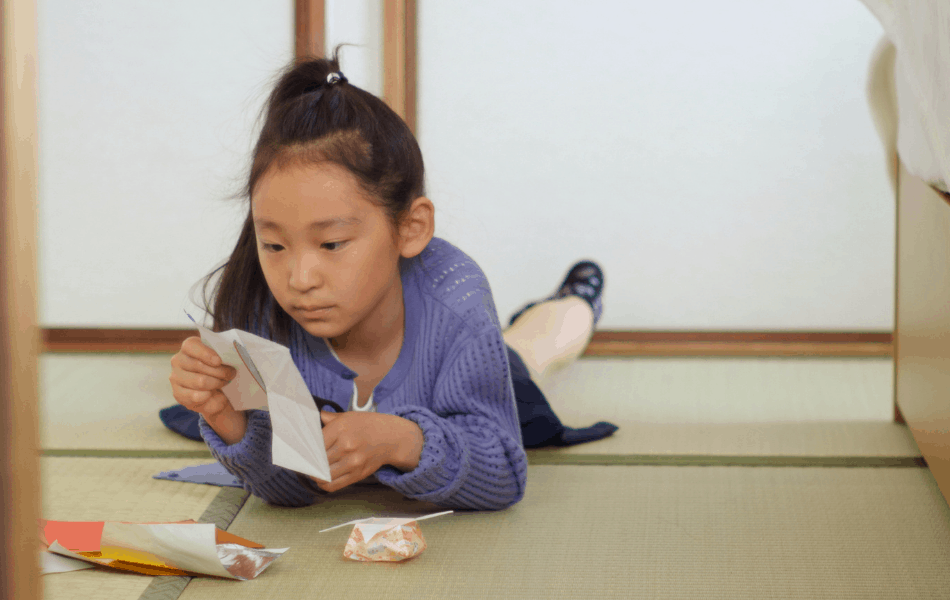
The rooms are divided by sliding doors (shoji). Shoji is made from wooden frames and translucent paper, which allows the light through. Glass is not historically used. Wooden verandahs go right around the house.
The interior walls and doors are made up of fusuma. Fusuma are sliding panels that can be taken apart quickly to allow one room to be changed into another shaped room quickly. Space is valued and respected in Japan. They can be made from cloth, paper, wood, or cardboard.
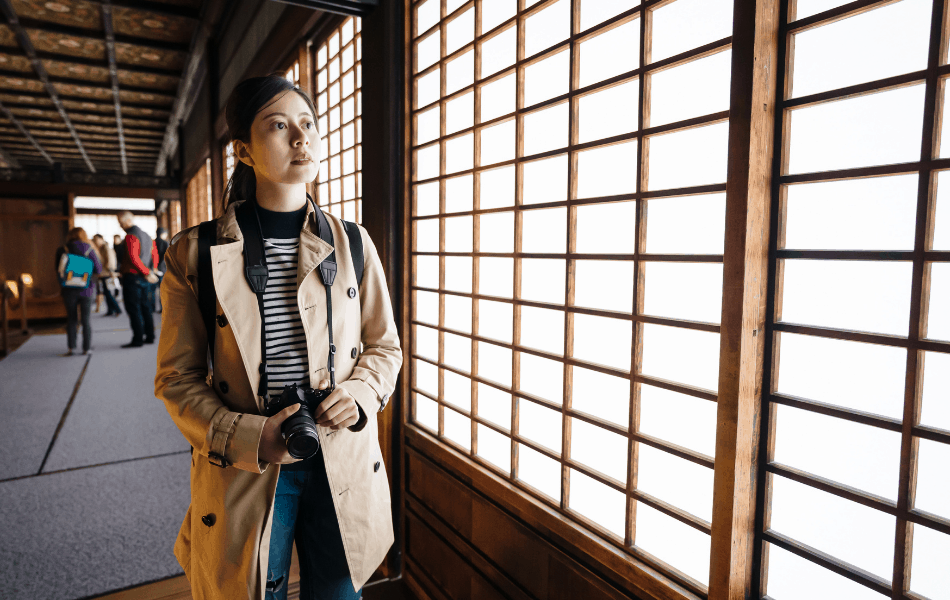
Imagine not using nails in constructing a home. The advanced carpentry that the Japanese practice is that they use advanced wooden joints tied with rope to join frames. This is known as wagoya.
When you go into the main entrance, you will go into the genkan. This is the area where you remove your shoes. The tradition goes that if you enter anyone’s home you take your shoes off. If you don’t it is regarded as very bad manners.
Sit on the floor you sit on a thin pillow called a zabuton. The table in front of you with short legs is called a chabudai.
Did you know it is customary to clean yourself before entering the ofuro (bath)?
The bath (ofuro) is in a separate room from the toilet, normally with an attached dressing room. The bath itself is deep but not that long. The toilet is very different in Japanese homes to what the West is used to. It heats the seat and will wash and dry you after you are done.
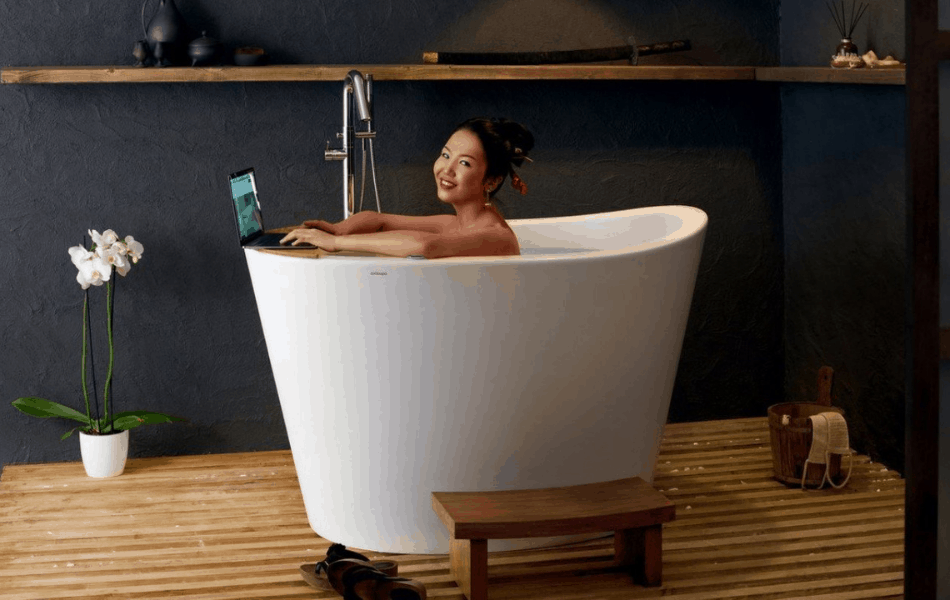
Did you know that Japanese homes are constructed so they last only 30 years? This is the way the economy and construction will keep busy.
Surrounding the homes, you will find tall walls. Today, many of these walls are concrete, but you will also find numerous traditional walls made from bamboo. The Japanese have many superstitious beliefs concerning stones and when you do get a chance to peer into a garden, you will see large stones.
They are valued for their beauty but often are also worth a great deal of money too. These stones lay out the framework of the garden. It is told that a Japanese garden is a “poem” and the mood of the soul. Water features also play an important part. A tree or trees are predominant.
Did you know if you have a bicycle in Japan it has to be registered and have a sticker? If not it could be confiscated.
How do you Greet People in Japan?
- Bowing is the way to do it! A longbow from the waist is a way of showing great respect. A short bow or nod is more casual and informal.
- Learn the word “hajimemashite.” This is what you say when you meet someone for the first time. It translates to “Nice to meet you.”
- Public displays of hugging or kissing on both cheeks are a no-go in Japan. Stick to bowing!
- We are encouraged to look the person in the eye when we greet them. Nope is Japan, don’t do that. It is a sign of aggression.
- When greeting someone, greet them by using their family name plus “san”. Not wise to call them by their names. If you do not know their family name just call them “san”. Sama is used for those above you. Kun is a young boy and a good male friend. Chan is for young children and close female friends.
7 Epic Etiquette Tips While in Japan
- If you are giving someone something, use both hands to pass that item over to that person and the same thing applies when you are receiving something from someone, including food or a drink, use both hands
- Whatever happens, if you need to blow your nose, don’t do that in public. Go to a bathroom or private place to do so.
- When on public transport, using your cell phone, with pleasure listen to music or audiobooks, but rather do not have a conversation. This is regarded as terribly rude.
- Have drinks with new friends? Don’t kill the friendship before it has started by pouring yourself a drink or topping your own drink up. Top up others’ drinks, but wait for them to top yours up.
- While walking around and you spot something amazing or want to go towards something, don’t point in that direction! This is so rude in Japan. Rather wave your hand in that direction.
- Tipping is regarded as an insult, even if you go in a taxi or in a hotel. The price you are charged is what you pay.
- Exposing your shoulders is not appropriate. Leave those tank tops at home.
- Burping is regarded as extremely rude.
- Learn the language of the chopstick!
10 Protocol tips on how to use Chopsticks

Practice using your chopsticks at home before venturing to Japan. It is an art and they take the art of eating with hashi seriously! I love sushi and still, I struggle when using chopsticks. The Japanese call chopsticks “hashi” or the polite term “ohashi”. They are mostly made from wood or bamboo in Japan, but at certain restaurants, you will find plastic or metal chopsticks.
| Make your mind up on what food you want to eat before you choose with your chopsticks. Hovering above food is impolite. |
| The temptation to suck your hashi is there – but don’t! |
| In between mouthfuls, place your chopsticks down on the chopstick and rest. Leaving them standing vertically in the bowl of rice is regarded as bad luck. At a Japanese funeral, a bowl of rice is left with chopsticks standing vertically in the rice. You are not at a funeral. |
| Stabbing your food or pointing to someone with your chopsticks is a NO, NO! |
| Passing food from your chopsticks to someone else’s chopsticks is not polite. |
| When placing your chopsticks across your bowl while you are still eating, you will wonder why your bowl is whisked away with a scowl. It is rude not to finish your food in your bowl and placing them across your bowl tells your host you have finished eating. |
| Whatever happens, do not pick up the food that you choose and put it back because you decided you actually do not want it. If you pick it up, place it in your bowl and eat it! |
| Never rub a pair of chopsticks together. Cheap chopsticks sometimes have splinters and by rubbing them together you are indicating that you are rubbing the splinters off. |
| Need your dish closer to you, move it closer with your hands, not by using your chopsticks. |
| If you are been presented with a shared dish, don’t use your chopsticks to pick up the food from the dish that is circulating around the table. Use the utensils provided or turn your chopsticks around and dish up. This part of the chopstick has not been in your mouth. |
Did you know the Japanese have the lowest rate of obesity in both men and women and a reduced rate of cardiovascular disease?
How to Travel Around Japan
Japan has the world’s best transport system. It is reliable and exact. If a train is scheduled to arrive at a certain time, it will arrive at exactly that time. Most trains run for 24 hours but if you are out late make sure you know when the last train leaves. Also, make sure you know your station name, write it down and keep it with you,
Also, write down your accommodation address and the area where you are staying. Japanese is a different language and although a great many Japanese speak a bit of English, they will more than likely not be able to understand you. They prefer to read English, so always carry around a pen and a bit of paper.
Don’t think about driving yourself around. The tolls are high on the expressways and the cost of rental cars and fuel are substantially high. Never mind getting used to the expressways!
The most popular form of transport is by train and bus. Get the JAPAN RAIL PASS (JR Pass). This is a fabulous option! You can travel around Japan using a 7, 14 or 21 days pass. Jump on and off! JR national trains including Shinkansen bullet trains and Narita Express trains. You order the pass, standard or Green (first-class) online, which is called an exchange order and when you arrive in Japan, you get your pass. Fares and the purchasing of tickets can be rather complicated so it is advised to avoid all complications to get your JR Pass.
Did you know that getting from island to island, it is not common to go by boat, but rather by air which is cheaper?
What tourists love to See and Visit in Japan
Yes, you can get a brochure on what to see and attempt to do the tour yourself, but being such a foreign culture and country, it is wise to use a tour guide. They know all the best places and can get you in and out quicker than you can. You want to avoid extremely long queues and because you are only there for a limited time frame, you want to see the best!
Castles
There are 12 original castles, try and see at least two of them. Matsumoto Castle is regarded as a National Treasure of Japan. Himeji Castle is the largest. How you and I envisage a “castle” is quite different from the castles of Japan.
.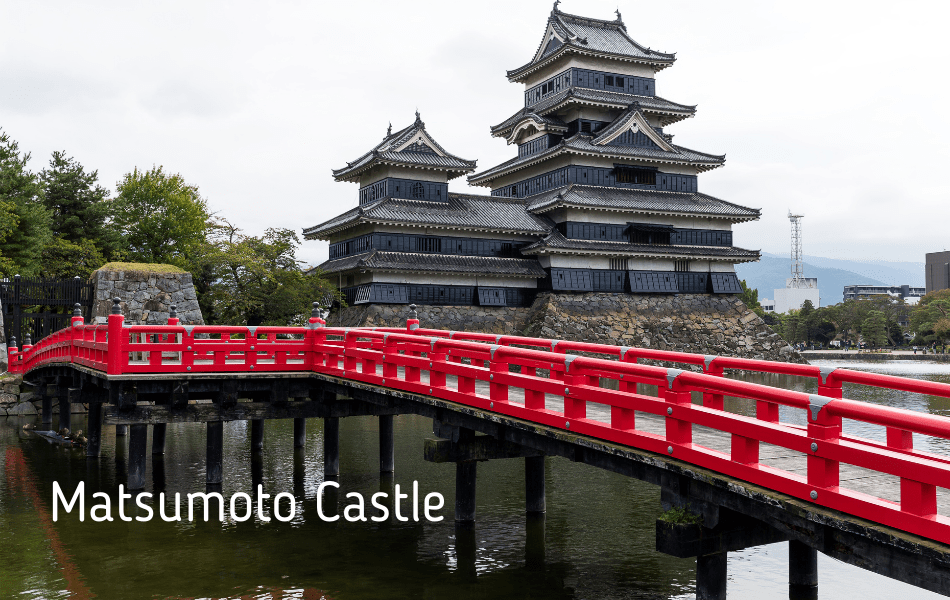
Shrines and Temples
Ise Grand Shrine is the most important, noteworthy, and beautiful shrine in Japan. It is regarded as the spiritual home of the Shinto people. This shrine is the home of the sun goddess Amaterasu. Do you know that every 20 years, the inner and outer shrines as well as the Uji Bridge, are taken down and completely rebuilt in keeping with Shinto beliefs of renewal and rebirth?
77,394 temples have been recorded in Japan! I would advise seeing one or two. The Great Buddha Hall ( Tōdai-ji Daibutsuden) in Nara is spectacular! The gargantuan bronze Buddha that sits once was the world’s largest wooden building. (The largest now is the Japanese stadium). This Buddha nearly bankrupted Japan in 751. There are treasures such as an octagonal lamp from the 700s. What really appeals to me is the deer at the temple. They are known as the Sika deer. It is as if they belong there and pose as the tourists take their pictures.
Gardens
Walking through a garden in Japan is rather like walking through heaven as we imagine it to be. Paradise, tranquillity, peaceful, soulful, magnificent, and surreal beauty. There are numerous gardens but one I highly recommend is Kenroku-En.
It is also known as Kenrokuen. Kenrokuen means Six Attributes Garden. Six attributes of a perfect landscape: “spaciousness, seclusion, artifice, antiquity, waterways, and panoramas“. It is positioned in the center of Kanazawa City. It was originally the private garden of the Maeda family, alongside the Kanazawa Castle. Did you know it took over 200 years to complete this garden, from the 1620s to the 1840s?
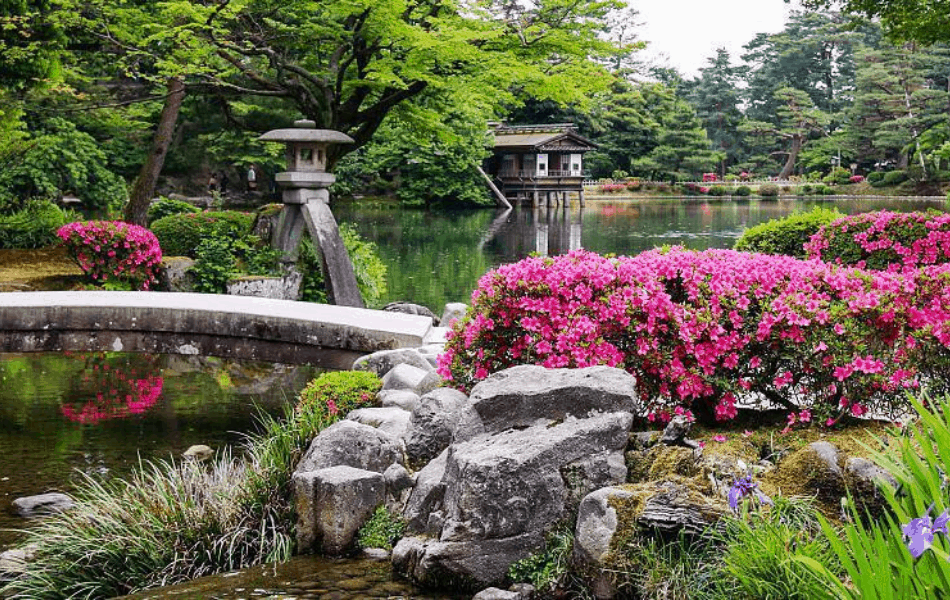
“花鳥風月 (Kachou Fuugetsu) Literally: Flower, Bird, Wind, MoonMeaning: Experience the beauties of nature, and in doing so learn about yourself.“
Now for some FUN: – Epic day to be had as a Super Hero Go-kart rider on the streets of Tokyo
Let us not be so serious! Go and have some fun at street karting in the city of Tokyo. You dress up in your favorite costume, put your own choice of cool music on, and go for a tour of Tokyo. How cool is this!! You need an international driver’s license.
Other drivers on the streets respect the go-kart riders. The karts exceed safety regulations and are safe. You can have communication bands to talk to your friends and action cameras to record your trip. A must as no one back home will believe what you did! The only problem with this tour is that you will want to do it again and again and you won’t be able to stop talking about it. Wow, Japan is incredible!
Are you looking at traveling to Japan? Let us know in our comments section below your travel ideas so others can benefit from them too.
Recent Posts
Discover insider tips to find cheap flights from the UK, save on easyJet, Ryanair & BA, and score the best weekend and last-minute deals. Why You’re Paying Too Much for Flights Most UK...
Discover the sounds of travel, from laughing kookaburras to market chatter, church bells to ocean waves - a journey heard as much as seen. It always starts with a sound. The other day, walking...


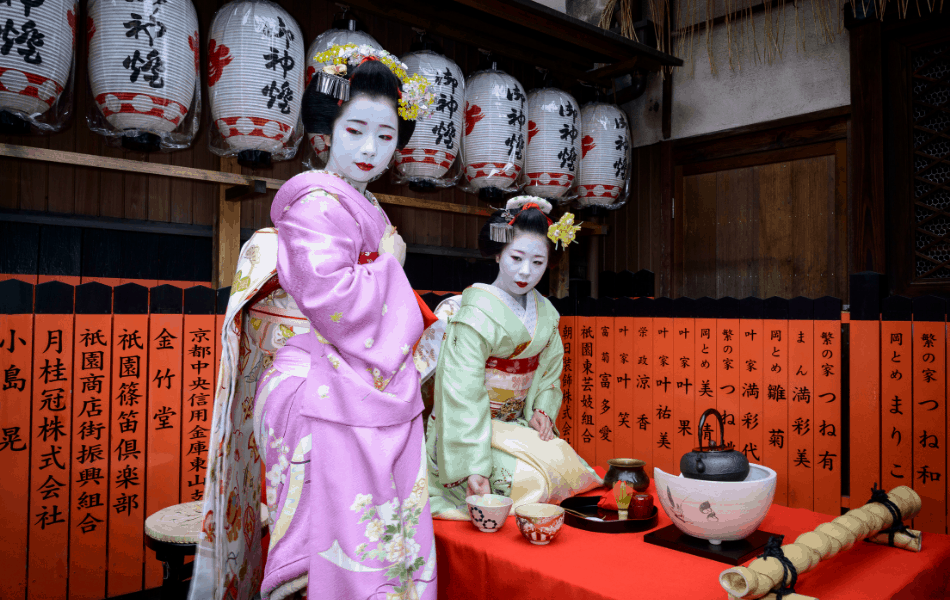
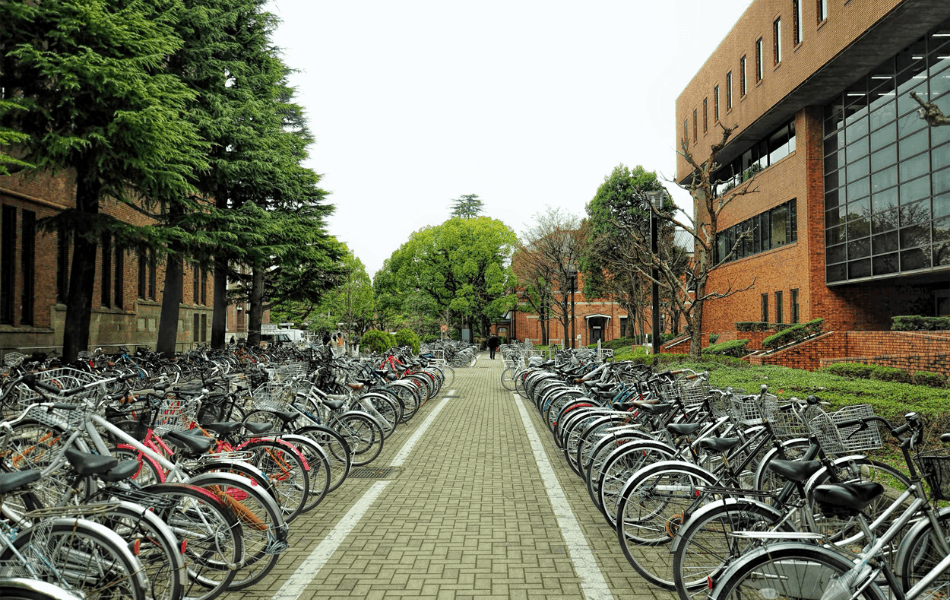
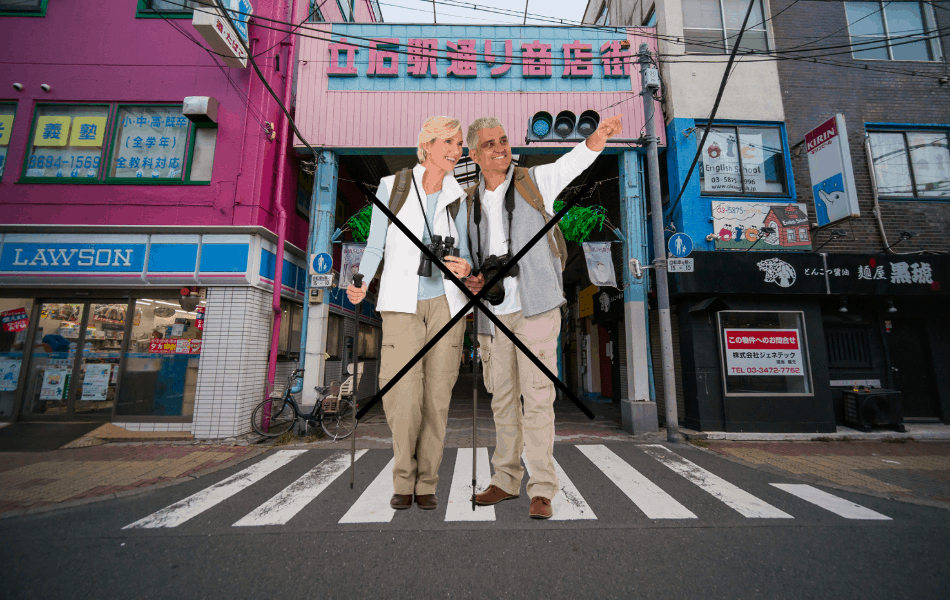
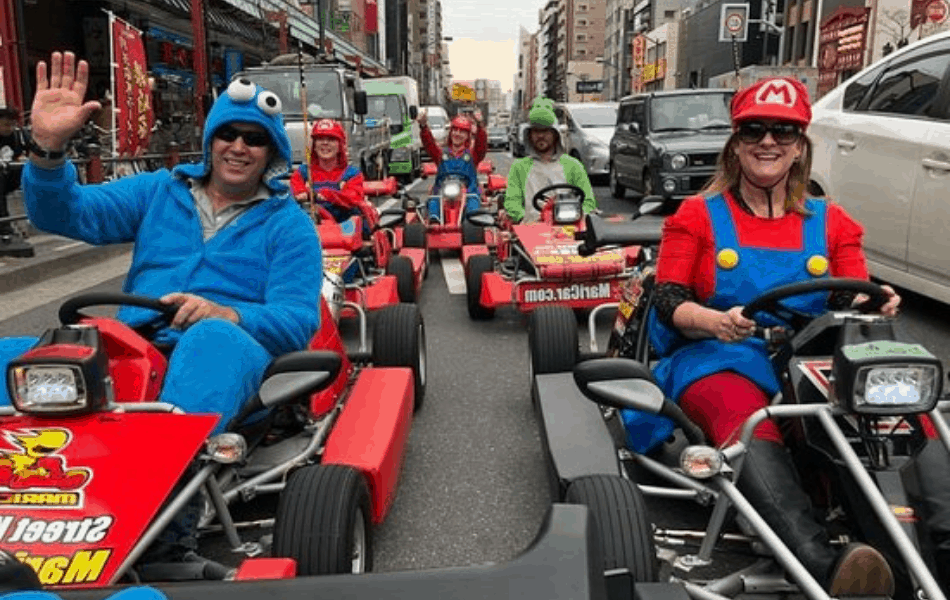
One thought on “Reasons Why You Should Visit Japan”
Comments are closed.